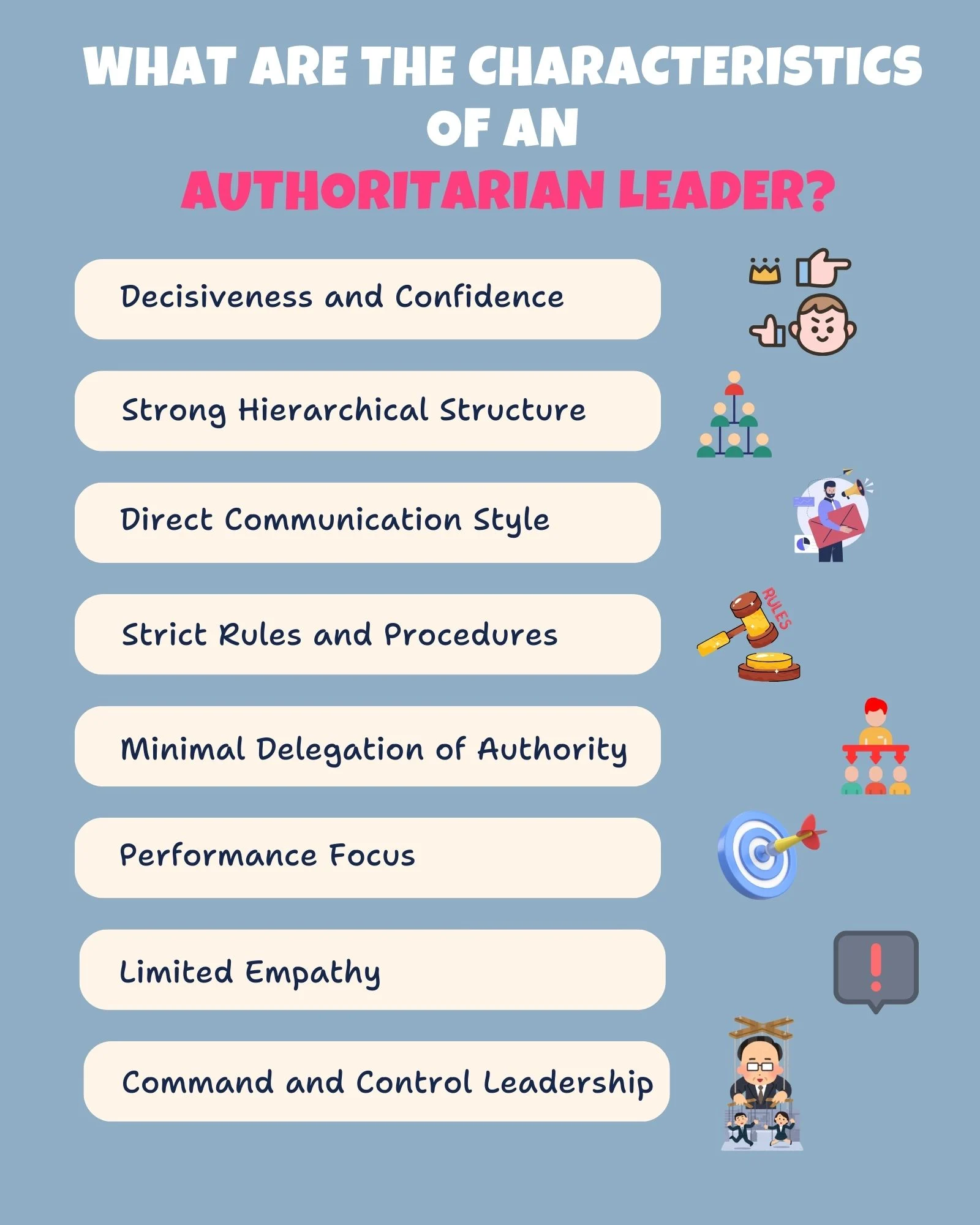- Table of Contents
- Definition of Authoritarian Leadership
- What Are the Characteristics of an Authoritarian Leader?
- Decisiveness and Confidence
- Strong Hierarchical Structure
- Direct Communication Style
- Strict Rules and Procedures
- Minimal Delegation of Authority
- Performance Focus
- Limited Empathy
- Command and Control Leadership
- Benefits of Authoritarian Leadership
- Quick Decision-Making in Crisis
- Clarity and Order
- Efficient Execution
- Swift Implementation of Strategies
- Streamlined Communication
- Stability in Established Environments
- Alignment with Autocratic Cultures
- Clear Accountability
- Cons of Authoritarian Leadership
- Reduced Creativity and Innovation
- Low Employee Morale and Job Satisfaction
- Resistance and Communication Barriers
- Limited Employee Development
- High Turnover Rates
- Inflexibility in Dynamic Environments
- Lack of Innovation and Risk-Taking
- Dependence on the Leader
- How Does an Authoritarian Leadership Style Affect Negotiation?
- Authoritarian Leadership vs. Authoritative Leadership
- Authoritarian Leadership:
- Authoritative Leadership:
- Authoritarian Leadership in the Technological Era
- Challenges:
- Opportunities:
- The Balance with New Leadership Styles:
- Conclusion
Introduction
Leadership is a multifaceted concept that can take various forms, and one of the most discussed styles is authoritarian leadership. This approach, characterised by strong, top-down control, has both fervent supporters and fervent critics. In this blog post, we will delve into the world of authoritarian leadership, examining its definition, key characteristics, benefits, drawbacks, impact on negotiation, and how it differs from authoritative leadership.
Definition of Authoritarian Leadership
Authoritarian leadership can be defined as a style in which leaders exert a high level of control and decision-making power over their subordinates. In this model, the leader assumes a dominant role and expects strict adherence to instructions and policies. The focus is often on the leader's authority and maintaining order within the organisation.
What Are the Characteristics of an Authoritarian Leader?
When exploring the characteristics of an authoritarian leader, it becomes evident that this leadership style is defined by several key traits that shape their approach to managing and directing their teams.

Decisiveness and Confidence
Authoritarian leaders are known for their decisiveness and unwavering confidence in their decision-making. They are quick to make choices without seeking extensive input from others. This trait often stems from their belief that their authority and expertise make them the most qualified to determine the best course of action for the organisation.
Strong Hierarchical Structure
An authoritarian leadership setup establishes a clear and rigid hierarchical structure, with the leader positioned at the top. Instructions and directives are expected to flow down through the ranks, with little room for lateral communication. This ensures a clear chain of command and minimises confusion in decision implementation.
Direct Communication Style
One of the defining characteristics of an authoritarian leader is their preference for one-way communication. They communicate their decisions and expectations directly to their subordinates without actively seeking feedback or inviting discussion. This unilateral approach to communication reinforces the perception of their authority and control.
Strict Rules and Procedures
Authoritarian leaders promote strict rules and procedures within the organisation. They establish clear guidelines and protocols and expect their team members to adhere to them diligently. This emphasis on rules is intended to maintain order and consistency but may also limit creativity and adaptability.
Minimal Delegation of Authority
In an authoritarian leadership style, decision-making and authority tend to be centralised around the leader. While they may delegate some tasks, they rarely delegate substantial decision-making power to their team members. This centralised control allows them to grip the organisation's direction tightly.
Performance Focus
Authoritarian leaders are highly results-oriented, prioritising efficiency and productivity. They set high standards and expectations for their team members, often pushing them to achieve ambitious goals. This focus on performance can benefit certain contexts but may also lead to burnout and stress for employees.
Limited Empathy
Empathy is often not a primary trait associated with authoritarian leaders. Their focus on goals and results may lead them to overlook the emotional well-being of their team members. Consequently, this lack of empathy can decrease job satisfaction and a strained leader-employee relationship.
Command and Control Leadership
The authoritarian leader's approach can be summarised as "command and control." They believe that strong direction and a firm hand are necessary to keep the organisation on track and maintain employee discipline.
It's essential to recognise that authoritarian leadership is not universally effective. Its success largely depends on the leader and team's specific context and personalities. While it may work well in certain situations, such as military operations or highly regulated industries, it can create challenges in dynamic and innovative environments that require open communication, collaboration, and employee empowerment.
Benefits of Authoritarian Leadership
The authoritarian leadership style, despite its criticisms, does offer some benefits in specific situations and contexts. In fact, according to Leadership IQ, around 21% of employees believe that authoritarian leadership does have its share of benefits. So, let's delve deeper into these advantages:
Quick Decision-Making in Crisis
Swift decision-making is crucial in times of crisis or emergency. Authoritarian leaders excel in such situations because they possess the confidence and authority to make critical choices promptly. This ability to act decisively can prevent delays and mitigate potential damages during emergencies. According to Forbes, approximately 21% of employees hold an idealised perception of a leader who always maintains sole decision-making authority.
Clarity and Order
One of authoritarian leadership's key strengths is its ability to establish a clear and organised work environment. The strict hierarchical structure and well-defined rules and procedures leave little room for ambiguity. Team members understand their roles and responsibilities, reducing confusion and enhancing overall productivity.
Efficient Execution
Authoritarian leaders' strong, top-down approach ensures that tasks and projects are executed with precision and adherence to deadlines. Their emphasis on accountability and the direct delegation of responsibilities leaves little room for procrastination or inefficiency.
Swift Implementation of Strategies
With an authoritarian leader at the helm, strategic decisions can be implemented rapidly and uniformly. There is no need to navigate multiple layers of decision-makers, as the leader's authority ensures that strategies are swiftly communicated and implemented.
Streamlined Communication
Authoritarian leaders provide clear instructions, leaving no room for misinterpretation or miscommunication. This streamlined communication style minimises the risk of misunderstandings and ensures everyone is on the same page.
Stability in Established Environments
Authoritarian leadership can help maintain stability in stable and predictable environments. When the business model is well-established and the organisation operates in a relatively static industry, an authoritative figure can keep things running smoothly without constant upheaval.
Alignment with Autocratic Cultures
An authoritarian leadership style may be more readily accepted and effective in cultures where hierarchical structures and respect for authority are deeply ingrained. This alignment can create a sense of familiarity and comfort among employees.
Clear Accountability
The authoritarian leadership style promotes clear lines of accountability. Team members know whom to report to and who is responsible for specific outcomes, reducing the risk of finger-pointing and promptly addressing issues.
While these benefits highlight the strengths of authoritarian leadership, it's crucial to recognise that they come with trade-offs. The benefits often revolve around maintaining control, efficiency, and stability. However, the rigid approach may hinder creativity, innovation, and the overall growth and adaptability of the organisation in dynamic and fast-changing environments–which will all be discussed in a minute.
Cons of Authoritarian Leadership
The cons of authoritarian leadership are critical to understanding as they shed light on the potential drawbacks and limitations of this leadership style. While authoritarian leaders may achieve short-term goals efficiently, their approach can have significant long-term negative consequences for both the organisation and its employees.
Reduced Creativity and Innovation
Authoritarian leadership tends to stifle creativity and innovation in the workplace. The strict adherence to rules and procedures leaves little room for employees to explore new ideas or challenge existing norms. As a result, team members may feel discouraged from contributing their unique perspectives and innovative solutions, ultimately hindering the organisation's ability to adapt and thrive in dynamic environments.
Low Employee Morale and Job Satisfaction
Under authoritarian leadership, the lack of employee involvement and participation in decision-making can lead to low morale and job dissatisfaction. Team members may feel undervalued, as the leader does not seek or value their ideas and contributions. Over time, this can result in disengagement, reduced productivity, and a higher likelihood of employee turnover.
Resistance and Communication Barriers
Authoritarian leaders often encounter resistance from team members who may feel disempowered or disregarded. The lack of open communication and feedback channels can lead to misunderstandings, as employees may hesitate to express their concerns or challenges. This lack of candid communication can contribute to a breakdown in trust and collaboration.
Limited Employee Development
In an authoritarian leadership environment, employees may have limited professional growth and development opportunities. The strict control and minimal delegation of authority mean that team members may not be exposed to new challenges or responsibilities that could facilitate their skill development and career advancement.
High Turnover Rates
Organisations led by authoritarian leaders may experience higher employee turnover rates due to low employee morale and limited growth opportunities. Talented employees seeking a more empowering and supportive work environment may choose to leave, leading to talent attrition and the loss of valuable expertise.
Inflexibility in Dynamic Environments
The rigid nature of authoritarian leadership can pose challenges in fast-changing and unpredictable environments. The inability to adapt quickly or consider alternative approaches may hinder the organisation's ability to respond effectively to new challenges or opportunities.
Lack of Innovation and Risk-Taking
Innovative ideas often involve an element of risk. However, authoritarian leaders' aversion to deviating from established procedures and practices can discourage employee risk-taking behaviour. This risk aversion can prevent the organisation from exploring new ventures and potential avenues for growth.
Dependence on the Leader
Authoritarian leadership can create a dependency on the leader's decisions and guidance. This dependence can lead to a lack of initiative and autonomy among team members, as they may become overly reliant on the leader's directions rather than taking ownership of their work.
Pros of Authoritarian Leadership | Cons of Authoritarian Leadership |
Quick Decision-Making | Lack of Creativity and Innovation |
Clear Chain of Command | Low Employee Morale |
Maintains Order and Discipline | Limited Employee Engagement |
Can Be Effective in Crisis Situations | Resistance and Lack of Initiative |
Clearly Defined Roles and Expectations | High Turnover Rates |
Efficient in Task-oriented Environments | Lack of Adaptability to Change |
Strong Leadership Presence | Limited Feedback and Communication |
Table 1: Pros and cons of authoritarian leadership
How Does an Authoritarian Leadership Style Affect Negotiation?
Authoritarian leadership styles can significantly impact the negotiation process, often leading to distinct dynamics compared to more collaborative leadership approaches. A clear power imbalance is evident in negotiations with an authoritarian leader, as the leader holds most of the decision-making authority. This power dynamic can create an environment where the subordinate party may feel pressured to consent to the leader's terms without much room for negotiation or compromise.
Furthermore, negotiations with authoritarian leaders tend to involve more unilateral decision-making. Rather than engaging in a give-and-take exchange of ideas and concessions, authoritarian leaders may be more inclined to impose their terms and expectations on the other party. This approach can limit the potential for mutually beneficial agreements and hinder the development of strong, long-term relationships with external parties.
Moreover, an authoritarian leadership style's limited openness to alternative perspectives can hamper information exchange during negotiations. Subordinates may be discouraged from providing candid feedback, leading to a lack of transparency and a potential misunderstanding of the other party's interests and concerns.
Additionally, the creativity and flexibility often required in negotiations may be restricted under authoritarian leadership. The leader's strict adherence to established rules and procedures may leave little room for exploring innovative solutions, potentially limiting the negotiation's outcomes and inhibiting opportunities for win-win scenarios.
An authoritarian leadership style in negotiations can result in a more assertive and one-sided process, which may be effective in certain situations where decisive action is required. However, it may also lead to missed opportunities for collaboration, compromise, and creative problem-solving that could lead to more mutually beneficial agreements. Leaders should be open to alternative perspectives to foster healthier negotiation dynamics, encourage two-way communication, and empower their teams to engage in collaborative decision-making processes.
Authoritarian Leadership vs. Authoritative Leadership
Authoritarian Leadership and Authoritative Leadership are two distinct styles of leading teams or organisations, each with its own set of characteristics and impacts on the work environment.
Authoritarian Leadership:
- Approach to Decision-Making: Authoritarian leaders make decisions independently without consulting their team members. They have a top-down approach where instructions and guidelines flow from the leader to the subordinates without much room for discussion or input.
- Communication Style: Authoritarian leaders tend to use one-way communication, where they give orders and expect them to be followed without question. There is limited feedback from the subordinates, and the communication is generally formal and hierarchical.
- Employee Empowerment: Employees have little autonomy or decision-making power in this style. The leader dictates most tasks and responsibilities. There is a lack of empowerment, and employees often have limited opportunities to showcase their skills or take initiative.
- Employee Satisfaction: This leadership style is often rigid and controlling, which can reduce employee satisfaction. Employees might feel demotivated or undervalued, which can decrease morale and productivity. High levels of control can also create a tense work environment, reducing job satisfaction.
Authoritative Leadership:
- Approach to Decision-Making: Authoritative leaders also provide clear direction but are open to input from their team members. They value collaboration and consider their team's opinions and expertise before making decisions. This approach fosters a sense of shared responsibility and involvement among team members.
- Communication Style: Authoritative leaders promote open communication and dialogue. They encourage team members to express their ideas, concerns, and feedback. This two-way communication creates a collaborative and inclusive work environment where everyone's voice is heard and valued.
- Employee Empowerment: Authoritative leaders delegate tasks and responsibilities to their team members, trusting them to perform their roles effectively. This empowerment encourages employees to take ownership of their work, boosting their confidence and motivation. Team members feel valued and trusted, leading to a positive work environment.
- Employee Satisfaction: Authoritative leadership's participative nature tends to make employees more satisfied and engaged. They feel motivated to contribute to the organisation's goals and are likelier to invest their time and effort in their work. The collaborative atmosphere and empowerment lead to higher job satisfaction among employees.
In summary, while authoritarian leadership relies on strict control and limited employee involvement, authoritative leadership embraces collaboration, open communication, and empowerment, resulting in a more satisfied, motivated, and productive workforce. The choice between these styles often significantly impacts an organisation's overall culture and success.
Aspect | Authoritarian | Authoritative |
Decision-Making | Independent, no team input | Collaborative, values team input |
Communication | One-way, formal orders | Two-way, open dialogue, feedback |
Empowerment | Limited, strict control | Delegates, trusts, encourages |
Employee Satisfaction | Low morale, dissatisfaction | High engagement, motivation |
Table 2: Key differences between authoritarian and authoritative leadership styles
Authoritarian Leadership in the Technological Era
In the ever-evolving technological landscape, leadership styles have adapted to harness the power of innovation and digital advancement. Authoritarian leadership, characterised by a top-down approach with centralised control and limited employee autonomy, faces both challenges and opportunities in this dynamic environment.
Challenges:
1. Lack of Adaptability: Authoritarian leaders often struggle to adapt swiftly to rapid technological changes. In a digital era where trends shift overnight, rigid leadership can hinder an organisation's ability to pivot and embrace new technologies, limiting its competitive edge.
2. Limited Collaboration: Technology thrives on collaboration and shared knowledge. Authoritarian leaders, by nature, limit the flow of ideas and hinder open discussions, inhibiting the collaborative spirit essential for technological innovation. Team members might hesitate to share their technological insights in an environment where their input is not valued.
Opportunities:
1. Clear Direction in Chaos: Amidst the fast-paced technological advancements, there are moments of chaos and uncertainty. Authoritarian leaders can provide clear directives during such times, ensuring the team stays focused on strategic goals. Decisiveness can be an asset in steering the organisation through digital disruptions.
2. Hierarchical Structures in Tech Companies: Interestingly, some tech giants have maintained hierarchical structures, akin to authoritarianism, at least in certain aspects of their operations. This structure can ensure that crucial decisions are made efficiently, aligning with the company's vision and mission.
The Balance with New Leadership Styles:
However, the tech industry has also witnessed the rise of leaders who blend authoritative elements with adaptability. Successful tech companies often embrace authoritative leadership, fostering an environment where employees can experiment, innovate, and share their ideas freely. Such leaders value collaboration, recognising that the best technological solutions often emerge from diverse and inclusive teamwork.
In short, while authoritarian leadership can offer stability and a clear sense of direction in the technological era, it must coexist with more flexible and collaborative approaches. Embracing the benefits of authoritative leadership, which promotes active participation, open communication, and empowerment, can lead tech organisations toward a future where innovation and adaptability thrive, ensuring sustained success in the digital age.
Conclusion
With its focus on top-down control, authoritarian leadership has merits and drawbacks. It can be effective in certain situations, such as during crises requiring quick decisions. However, in the long run, its limitations on creativity, collaboration, and employee morale may hinder an organisation's growth and success.
As leadership philosophies continue to evolve, authoritative leadership, emphasising collaboration and empowerment, is increasingly gaining recognition as a more effective and sustainable alternative. By balancing control and openness, authoritative leaders foster an environment of innovation, employee engagement, and long-term success.
In conclusion, understanding the nuances of different leadership styles, including the authoritarian and authoritative approaches, can help organisations make informed choices about their leadership direction and create environments that nurture the full potential of their teams.
In light of the complexities surrounding authoritarian leadership, mastering effective techniques through our course ‘Authoritarian Leadership Techniques to Achieve a Vision’ can equip you with the necessary skills to navigate this style responsibly, harness its benefits, and address its limitations for a well-rounded approach to leadership. So, make sure you check it out and contact us for more information.
























